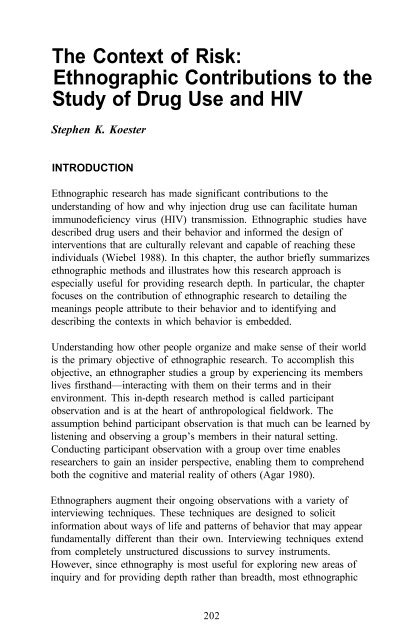The Context of HIV Risk Among Drug Users and Their Sexual Partners
The Context of HIV Risk Among Drug Users and Their Sexual Partners
The Context of HIV Risk Among Drug Users and Their Sexual Partners
You also want an ePaper? Increase the reach of your titles
YUMPU automatically turns print PDFs into web optimized ePapers that Google loves.
<strong>The</strong> <strong>Context</strong> <strong>of</strong> <strong>Risk</strong>:<br />
Ethnographic Contributions to the<br />
Study <strong>of</strong> <strong>Drug</strong> Use <strong>and</strong> <strong>HIV</strong><br />
Stephen K. Koester<br />
INTRODUCTION<br />
Ethnographic research has made significant contributions to the<br />
underst<strong>and</strong>ing <strong>of</strong> how <strong>and</strong> why injection drug use can facilitate human<br />
immunodeficiency virus (<strong>HIV</strong>) transmission. Ethnographic studies have<br />
described drug users <strong>and</strong> their behavior <strong>and</strong> informed the design <strong>of</strong><br />
interventions that are culturally relevant <strong>and</strong> capable <strong>of</strong> reaching these<br />
individuals (Wiebel 1988). In this chapter, the author briefly summarizes<br />
ethnographic methods <strong>and</strong> illustrates how this research approach is<br />
especially useful for providing research depth. In particular, the chapter<br />
focuses on the contribution <strong>of</strong> ethnographic research to detailing the<br />
meanings people attribute to their behavior <strong>and</strong> to identifying <strong>and</strong><br />
describing the contexts in which behavior is embedded.<br />
Underst<strong>and</strong>ing how other people organize <strong>and</strong> make sense <strong>of</strong> their world<br />
is the primary objective <strong>of</strong> ethnographic research. To accomplish this<br />
objective, an ethnographer studies a group by experiencing its members<br />
lives firsth<strong>and</strong>—interacting with them on their terms <strong>and</strong> in their<br />
environment. This in-depth research method is called participant<br />
observation <strong>and</strong> is at the heart <strong>of</strong> anthropological fieldwork. <strong>The</strong><br />
assumption behind participant observation is that much can be learned by<br />
listening <strong>and</strong> observing a group’s members in their natural setting.<br />
Conducting participant observation with a group over time enables<br />
researchers to gain an insider perspective, enabling them to comprehend<br />
both the cognitive <strong>and</strong> material reality <strong>of</strong> others (Agar 1980).<br />
Ethnographers augment their ongoing observations with a variety <strong>of</strong><br />
interviewing techniques. <strong>The</strong>se techniques are designed to solicit<br />
information about ways <strong>of</strong> life <strong>and</strong> patterns <strong>of</strong> behavior that may appear<br />
fundamentally different than their own. Interviewing techniques extend<br />
from completely unstructured discussions to survey instruments.<br />
However, since ethnography is most useful for exploring new areas <strong>of</strong><br />
inquiry <strong>and</strong> for providing depth rather than breadth, most ethnographic<br />
202
















